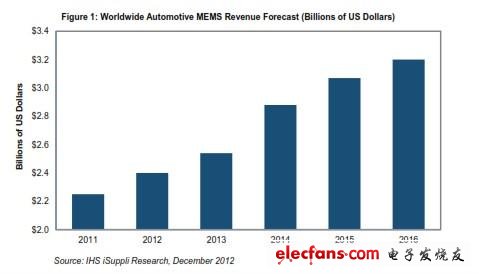According to IHS iSuppli's automotive MEMS market tracking report, due to the cooling of new car shipment growth, the growth momentum of the automotive MEMS market will be weakened, but due to the rising safety equipment assembly rate and facing pressure to reduce emissions, it will then usher in an expansion phase.
It is expected that this year's automotive MEMS operating income will rise from 2.25 billion US dollars in 2011 to 2.40 billion US dollars, an increase of 6.6%. The growth rate is expected to decline to 5.8% in 2013, and then rebound to 13.4% in 2014, when the operating income will increase to 2.88 billion US dollars, as shown in Figure 1.

Figure 1: Global automotive MEMS operating revenue forecast (in billions of dollars)
By 2016, automotive MEMS operating income will reach 3.20 billion US dollars, an increase of 4.4%. At that time, due to the weakening demand for automotive safety equipment such as electronic stability control (ESC) and tire pressure monitoring system (TPMS), the automotive MEMS sensor market will stabilize. By that time, the installation rate of these systems will reach the level required by regulations, which will cause the growth of automotive MEMS to become more moderate.
ESC uses multiple sensors to detect and suppress skidding, and is increasingly used in the United States, Europe, Australia, South Korea, and Japan. TPMS is used to monitor the air pressure inside pneumatic tires. The United States, Canada, China, South Korea, and Europe all require cars to be equipped with this system.
Although the growth rate of new car shipments in Europe and China will slow down, the overall market for MEMS sensors will continue to grow very strongly, and the automotive MEMS field will also benefit.
New impetus for growth
After 2015, several factors will drive the growth of the automotive MEMS market.
One of them is the growth of the Chinese TPMS market, with sales expected to reach US $ 190 million. The deadline for compulsory installation of TPMS is relatively late and will have to wait until mid-2015. At that time, as the TPMS market in other regions matures, the Chinese TPMS market will stand up in time to drive the growth of the entire industry.
Car rollover detection will be another rapidly growing field of application. The United States introduced a new car safety regulation, that is, car manufacturers must take measures to prevent passengers from being ejected from the car during a car rollover accident. This regulation will stimulate the market for gyroscopes and accelerometers for this application to grow by 18% in five years.
The third stimulus will be the gasoline direct injection (GDI) engine. This engine has a high power factor and efficiency, and is a key technology to help automobiles meet the carbon emission standards of the mature automobile market.
Europe is at the forefront of the world in adopting the GDI fuel system. Daimler Move, Ford Sigma and Fox, Peugeot EB, Renault / Nissan SIG and the EA111 / 2111 transmission systems in various Volkswagen models have adopted this technology. However, the share of GDI in North America will eventually surpass the rest of the world, because gasoline engine production in this region accounts for the majority. The share of GDI in China is low, but it will continue to grow. While Japan is showing a trend towards miniaturization, the focus is on smaller GDI turbocharged engines.
Another important sensor field driving the growth of the automotive MEMS market is the vacuum brake booster. After the application of stop and start, the development of vacuum brake booster has also accelerated. In this application, the pressure sensor provides parameters about the vacuum in the brake system: according to the pressure change during braking, a pump is activated and generates additional vacuum to increase the braking force. As the market allocation rate of the stop-start system rises, the shipment of vacuum brake booster equipment will increase by 34.5% from 2011 to 2016, reaching 18.9 million sets.
The soon-to-be-implemented requirement to install an e-call (emergency call) to the telematics system will also stimulate the sales of sensors, especially cars in the European market. A dedicated accelerometer will gain growth potential. In a car with an e-call system installed, the system will automatically call the nearest emergency handling center in the event of a car accident, greatly reducing the response time. The regulation will be officially implemented at the end of the second quarter of 2015 and is expected to affect all new cars sold in the European region.
Main MEMS devices and applications
At present, the four types of devices together account for 99% of automotive MEMS systems. They are pressure sensors, accelerometers, gyroscopes and flow sensors, and their five-year growth rate is 3-12%. The fifth device is a miniature bolometer. When the night vision system starts to grow rapidly in 2016, the importance of this device will also increase.
In terms of sales, the five largest automotive MEMS applications this year are ranked in descending order: ESC, airbag, absolute pressure of intake manifold (MAP), TPMS and rollover detection.
The Piezoelectric Ceramic sound-generating element, especially a lead-free piezoelectric ceramic sound-generating element, is mainly composed of metal flakes and piezoelectric ceramic flakes. The sound pressure generated by this new structure piezoelectric sounder is proportional to the number of piezoelectric ceramic sheets. By increasing the number of piezoelectric ceramic sheets, the required large sound pressure is easily achieved.
Custom Piezoelectric Components
Custom Piezoelectric Components,PZT Elements Soldered Wires,Element of Piezoelectric,Piezoelectric Elements Crystal
Zibo Yuhai Electronic Ceramic Co., Ltd. , https://www.yhpiezo.com